
table of contents
- White berries
- Yellow or orange berries
- Red berries
- Blue or purple berries
- Black berries
- frequently asked Questions
Berry bushes are not only found in the home garden. There are also many wild shrubs that bear berry fruits. The color of the berries can be used to determine the species.
In a nutshell
- Be careful with wild bushes, not all berries are edible
- Berry bushes are the habitat of many animals, especially birds
- Cultivated shrubs cannot always be clearly assigned to a color
White berries
White berry mistletoe (Visum album) - poisonous

In summer the mistletoes disappear in the foliage of their host trees, but in autumn when the trees begin to become bald, the small or larger round, green balls in the branches fall completely especially on. They are semi-parasites that tap into the pathways of trees. Mistletoes are subshrubs that never touch the ground. They bloom in March and bear fruit in winter. Mistletoes are popular as Christmas decorations. Mistletoe cannot be planted in the garden. However, apple trees can also be host trees for mistletoe. There are three subspecies of white berry mistletoe indigenous to Europe:
- Deciduous mistletoe
- Fir mistletoe
- Pine mistletoe
Common snowberry (Symphoricarpos albus) - poisonous
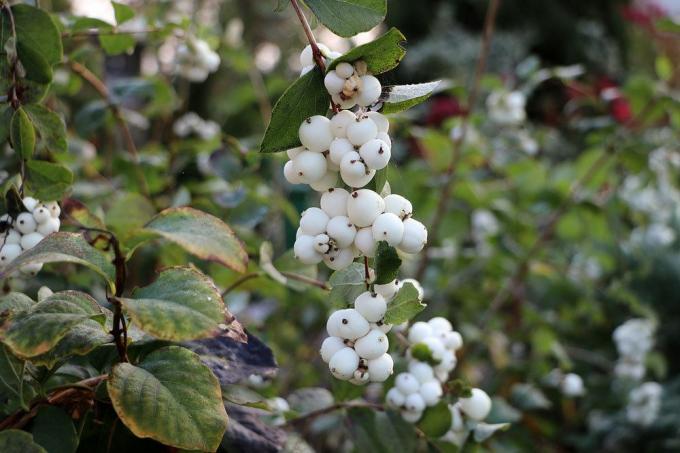
The snowberry is native to North America. In Europe it was introduced as an ornamental shrub and is now more and more common as a wild shrub in nature. Typical are the white fruits, which gave the plant the name Knallerbsenstrauch. In a sunny location, the crackling pea blooms from June to September. The fruits ripen between July and October.
Currant (Ribes) - edible
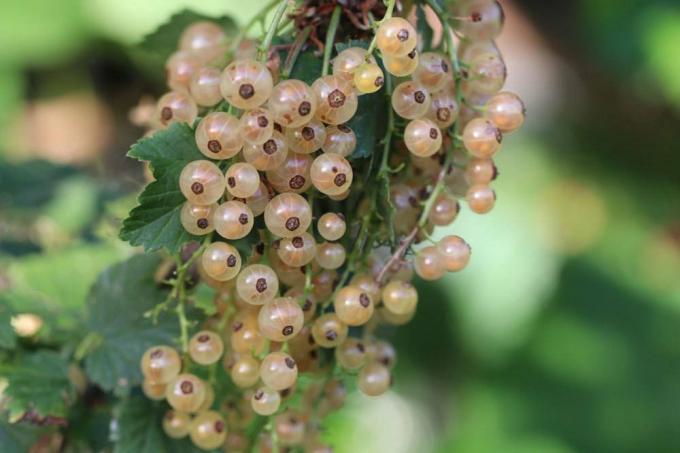
Currants are one of the most popular berry bushes in the garden. There are many different varieties that also have different berry colors. In addition to red-fruited varieties, there are also black and white currants. Currant bushes can grow wild and can then be found in the wild, for example at the edges of forests or in hedges. Due to the shape of the leaves and the typical panicles of berries, they are easy to distinguish from other berry bushes. Planting time in the garden is in autumn or spring. The flowering time is in April or May, the fruits ripen in summer and taste most aromatic in a sunny location.
Yellow or orange berries
Sea buckthorn (Hippophae rhamnoides) - edible
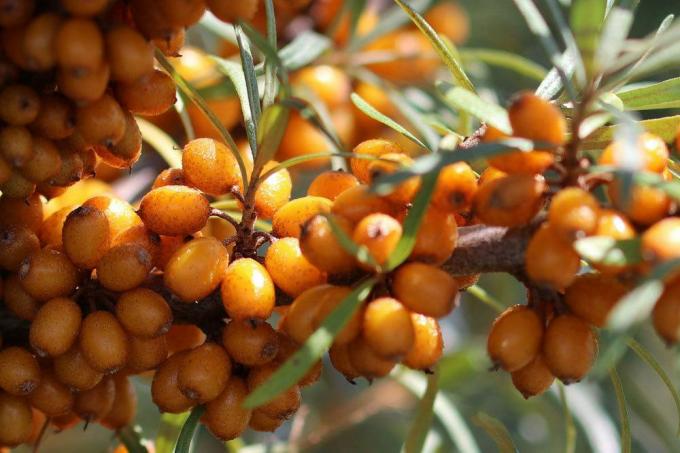
The sea buckthorn is particularly noticeable with its many orange-red berries. Only the female shrubs are fruitful, but they need a male shrub close by for pollination. Therefore, several shrubs should always be planted together. Sea buckthorn is also often used in hedge plantings as it is a valuable wood for birds and other animals. The harvest is difficult due to the many thorns, so you should wear gloves. The fruits are particularly rich in vitamin C.
Raspberry (Rubus idaeus) - edible

Raspberries are grown in the garden. They grow on a trellis and bloom and fruit on annual shoots that are connected to wires. The red fruits are extremely aromatic and the berries are mostly easy to care for. In the case of drought, watering is required, a mulch cover protects the shallow roots from drying out and composting in spring also ensures the supply of nutrients. In addition to red-fruity varieties, there are also yellow raspberries. Planting time is in autumn or spring, the location should be as sunny as possible.
Note: Yellow-fruited varieties are said to be less susceptible to fruit pests.
Gooseberry (Ribes uva-crispa) - edible
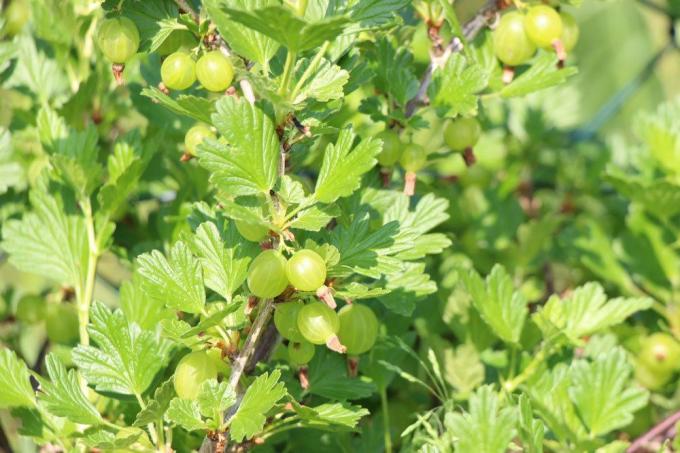
The gooseberry is also one of the crops that are popular to be grown in the garden. The fruits are white, red or green, depending on the variety. An important feature of the gooseberry are the spines that give it its name.
Care instructions:
- sunny location
- nutrient-rich soil
- mulch
- fertilize in spring
- water in case of drought
- cut out regularly
Firethorn (Pyracantha) - poisonous

Of the Firethorn is not at home in Germany, but is often planted as an ornamental wood in the garden because it is evergreen and the fruits ripen in an attractive color, ranging from yellow to orange to Red. In addition, the firethorn is considered a good bird protection wood. Its long thorns protect bird nests from predators and the fruits are part of the birds' food in winter. The bushes reach heights of up to 6 m.
Red berries
Common wolfberry (Lycium barbarum, also goji berry) - edible
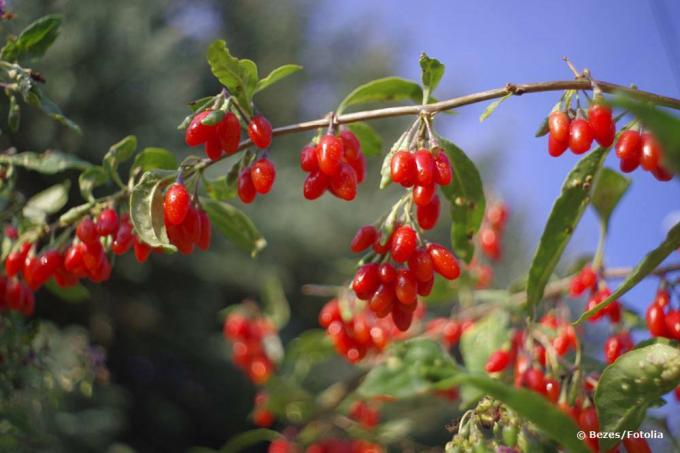
The native wolfberry was previously considered poisonous, it belongs to the nightshade family, as can also be recognized by the purple flowers. It is now known that the fruit is not only edible, but also very healthy. Goji berry plants for the garden are particularly available from organic nurseries. A root barrier should be used at the time of planting, as otherwise the wolfberry tends to overgrow and displace other plants.
Garden honeysuckle (Lonicera caprifolium, also true honeysuckle, fragrant honeysuckle or Jelängerjelieber) - not edible

The honeysuckle is not a native shrub, but is often found in the wild in shrubs and can therefore lead to confusion. In fact, honeysuckles belong to the lianas and are creepers that like to use other plants, trees, hedges or free-standing shrubs as climbing aids. Not only do the colorful, fragrant flowers appear in the foliage of the other plant, but also the small, red fruits that should not be eaten, their toxicity is unclear.
Note: Honeysuckles are also suitable as ground cover without a climbing aid.
Large-fruited cranberry (Vaccinium macrocarpon, also cranberry) - edible

The cranberry is mainly known by its English name and does not look like a native plant. In fact, it is a naturalized evergreen dwarf shrub that belongs to the heather family and grows in bogs. The name cranberry is derived from the flowers of the plant, whose stamens resemble a crane's beak.
Common barberry (Berberis vulgaris, also sea buckthorn, vinegar berry) - poisonous

The barberry grows up to 3 m high and is deciduous. The yellow flowers appear from May to June. The red berry is the only part of the plant that is not poisonous. Due to the high acid content, however, the fruits are rarely eaten; birds use them as food. Since the plant is an intermediate host of the grain rust, it was almost exterminated. Today it is far less common in nature than it used to be.
Blue or purple berries
Sloe (Prunus espinosa, also blackthorn, sour plum) - edible
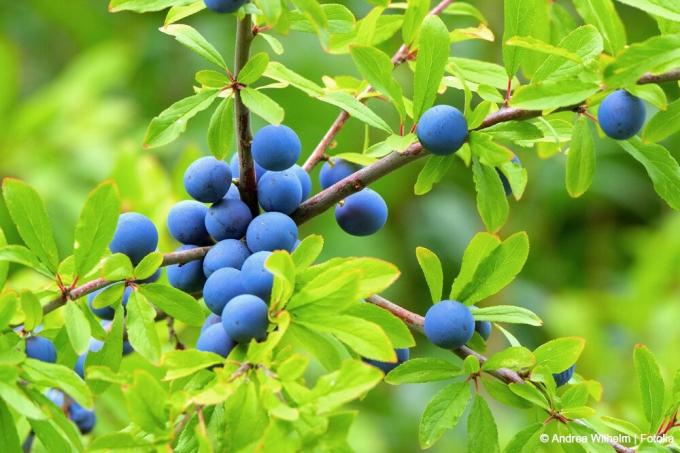
The sloe is a wild shrub that likes to spread in hedges and bird protection trees. In the garden, he absolutely needs a root barrier at the time of planting in order to keep the subterranean runners in check. The bushes are full of thorns that make harvesting difficult. The blue fruits are especially edible after the first frost. Before that, they contain too many tannins. Sloes should be boiled.
Bilberry (Vaccinium, also blueberry) - edible

The wild blueberry bushes that are native to our forests are not to be equated with the cultivated blueberries that are grown in the garden. This comes from North America. The most important difference can be seen in the purple or blue fruits. The cultivated blueberry has light-colored flesh, while the flesh of the wild species is dark in color. It occurs mainly in sparse forests. The wild species is considered to be more aromatic. The best time to plant the cultivated blueberry is in autumn.
Note: Wild blueberries should mat Wash before consumption to minimize the risk of the fox tapeworm.
Black berries
Chokeberry (aronia) - edible
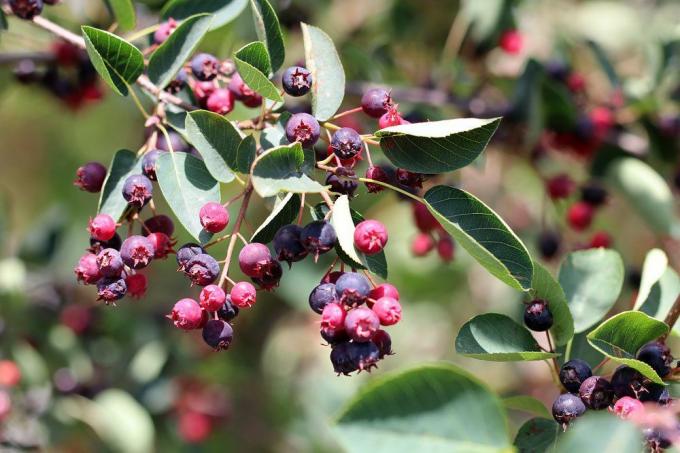
These shrubs are native to North America. Their fruits are considered superfoods, but are hardly edible raw because they taste very sour and tart. They are better suited for processing, for example with jam or juice. The aronia is a very attractive wood. In spring it shines with white flowers, in summer the fruits turn black and in autumn the leaves turn bright red.
Black elder (Sambucus nigra) - edible
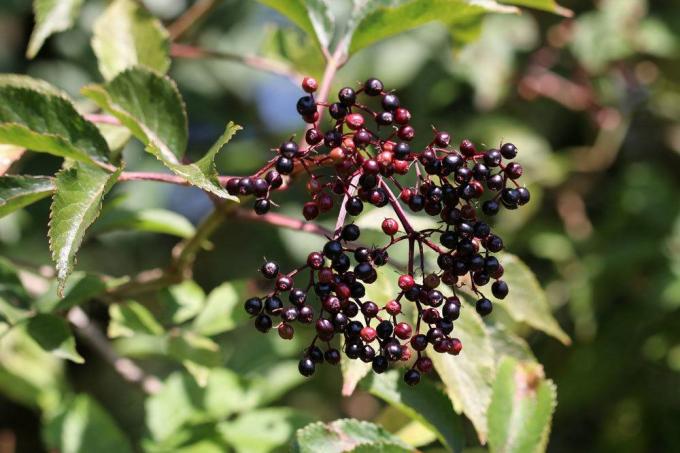
All parts of the black elder are considered to be poisonous, with the exception of the fully ripe, black fruits, which have to be cooked before consumption. The white, fragrant flowers can also be used in the kitchen and can be used to make syrup. The black elder is an upright, several meters high shrub, which is very noticeable due to the white flowers in spring and the black color of the fruits in summer / autumn. Elderberries in the forest can be attacked by a fungus, the so-called Judasohr, which, by the way, is edible.
Privet (Ligustrum, also Rainweiden) - poisonous
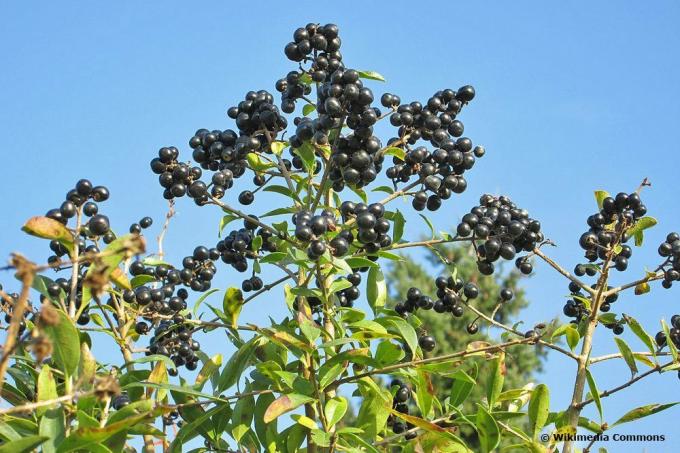
This popular hedge plant forms clusters of black berries that birds use as food. Privet grows several meters tall as a wild plant, in the garden the actual height depends on the pruning measures. The flower color is white. In addition to the wild privet, there are several cultivated varieties that can be planted in the garden for different purposes. Since privet belongs to the olive family, it is very drought tolerant.
Common bird cherry (Prunus padus, also Ahlkirsche, Swamp cherry, Elsenkirsche) - edible

The bird cherry normally grows as a tree, but can also appear as a shrub up to 10 m high. The black fruits give it its name because they are arranged like grapes. The white flowers open in April or May. The bird cherry is attacked by the web moth, which lays its larvae in the plant and the tree or shrub can eat completely bald, which does not damage the vitality of the plant, it strikes again after a while the end.
Dogwood (Cornus, also horn bush) - non-toxic, but inedible raw

The dogwood species includes the cornel, a tree with edible, red fruits. In addition, the red dogwood is widespread in Germany. Special features are the red shoots and the bright red autumn leaves. The flowering period extends from May to June. Often the bushes bloom a second time in late summer, when the fruits are already beginning to ripen. Fruits harvested fully ripe can be processed into jam.
Blackberry (Rubus, also dewberry) - edible

The blackberry is not only established as a cultivated plant in gardens, it also grows wild in the forest or in hedges, where it tends to grow rapidly and, because of the thorns, can form impenetrable undergrowth. However, these serve as a safe shelter for birds. For the garden there are cultivars (also with yellow fruits) that are thornless and make harvesting easier.
Care instructions:
- as full sun as possible
- nutrient-rich, well-drained soil
- Climbing aid
- Spring fertilization
- Mulching protects against dehydration
- Cutting back harvested rods
frequently asked Questions
If the bushes are safely identified, then berries from wild bushes can be collected in small quantities, similar to collecting mushrooms. However, this only applies to public places, if the land on which the shrub grows has an owner, this must be asked for permission.
This is not advisable for a number of reasons. On the one hand, edible berries are sometimes poisonous or inedible when raw. In addition, low berries can be a source of infection with the fox tapeworm. From around waist height, raw edible berries can be collected for immediate consumption.
Wild shrubs are basically very adaptable and also rather undemanding in the garden. Cultivated shrubs, on the other hand, are grateful for more fertilizer and more frequent watering. A pruning should also be done regularly in the interest of the yield.
